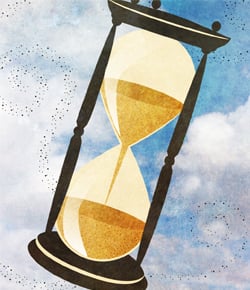Author’s Note: In a few cryptic lines from a letter written in 1947,1 the Lubavitcher Rebbe discusses the essential quality of Time. Along the way, Einstein’s relativity is dealt with in critical terms. Unfortunately, due to the cryptic style of the letter and the assumptions of knowledge it makes, the letter has been misunderstood or misinterpreted more than once. What follows is an attempt to clarify, in simple and concise terms, what this author believes to be the intent of this letter after review of the referenced material. Also provided are descriptions and elaborations of related comments of the Rebbe in other works. (For an annotated translation of the letter’s text, click here.)
1) Time as movement
Generally, when Time is discussed in philosophy or in science—including the works of classical Jewish philosophers—it is understood as movement, or change. The movement of the planets, the ticking of a clock—as long as these things occur, there is Time. If they cease, Time also ceases. In other words, Time is no more than the occurrence of physical events.
In this paradigm, once we accept the creation of heaven and earth ex nihilo, it is a simple conclusion that Time began then as well—since Time is no more than the events of the cosmos. The fact that we cannot fathom an absence of Time is irrelevant. After all, neither can we fathom an absence of heaven and earth—in other words, of space and matter. In this way Maimonides and most of the classic Jewish philosophers determine, contrary to the opinion of Aristotle, that Time is a creation with a beginning.
2) Time as a parameter of existence
There is, however, a deeper understanding of Time, mentioned only vaguely by some of the classic Jewish philosophers: the essence of Time—generally known as “immeasurable time.”
All science deals with the measurement of things.2 Indeed, it is a wondrous aspect of our universe that by measuring its phenomena we are able to calculate with some accuracy their outcomes.
But there are several limitations to this ability of ours. Of course, there are the subjective limitations: the precision of the tools of measurement, the form of measurement chosen, and even the consciousness of the subject who is measuring. Measurement is not really telling us directly about the phenomena we are measuring, but about the tools of measurement and our own relationship to them.
But, most profoundly, even once we have all the measurements of any particular object, we still have not grasped that object itself. In other words, we can absorb and process information about the object, but our knowledge and the actual object remain distinct entities.3 Our measurements provide us with a working model to make limited predictions, but the only true model is the thing itself.
The only true knowledge, then, is the knowledge of the Creator, who knows the object from its inside out, since the object is entirely one with Him. This is the knowledge that is contained in the Torah.4
Just as any object is not known in its essence by its measurement, so too with Time. Knowledge of change, movements, events—these are all measurements of Time. We could go even further: they are measurements of how things behave within Time. Time itself—Essential Time—is the parameter in which those events occur.
In this paradigm, Time is not dependent upon the existence of space and matter, but the converse: any event presumes the existence of a continuum of Time in which that event occurs. In fact, we can even extend this to the primal event, the initial emergence of space and matter: to say that before there was nothing, and then there was, already implies the existence of Time. Thus, Creation presumes Time, and not the other way around.5
3) Is Time Eternal?
The question can then arise: Is Time of G‑d’s essence? In other words: is Time an absolute given, like G‑d Himself, in which a universe occurs? Or is Time just another creation, as are space and matter?
Concerning this, there is some discussion amongst the classical Jewish philosophers. In his Sefer ha-Ikkarim, Rabbi Yosef Albo interprets Maimonides in his Moreh Nevuchim as implying that this “essential continuum of Time” may be eternal and without beginning. The resolution of Kabbalah and Chassidism is that even this essential aspect of Time was created out of the void at the initial point of Creation.6
The implications of this view are profound. In general, when the Jewish medieval philosophers wish to logically demonstrate that the universe began, they point to its essentially temporal nature. Everything is decaying, all systems work towards their own demise—therefore all things must have a beginning, or else they would have met their demise in the infinite past. This is similar to our concept of entropy and the current models of a temporally finite universe.
But in this paradigm, there is a question left over: What about those things that do not wither with time? Has the Pythagorean Theorem lost veracity since Pythagoras? Do Newton’s Laws of Motion weaken over time? Is the accumulative principle that 1 + 1 = 2 gradually decaying through use? If the answer is no, then the question arises: are these things eternal? Are they the necessary “ground of reality” like G‑d Himself?
Once we acknowledge that Time itself—the very essence of Time—is a creation, it becomes clear that all these things are also originated. Mathematics, logic—even Time and order—never had to be. Even once created, they could have been in entirely different forms. One plus one could have been three, or thirteen, for that matter. In the inimitable words of George Burns (playing G‑d), “Mathematics! Another one of My mistakes!”
4) Time as Order
But just what is this “Essential Continuum of Time”?
As we stated above, Torah, being neither an empirical science nor an intuitive philosophy, but rather a received tradition of divine wisdom, is able to discuss the essences of things. The field of Torah known as the Kabbalah provides insight into the essence of our physical universe by discussing how it exists in a far more abstract form in a hierarchy of higher worlds. Each higher plane of world has an increased affinity to the initial point of Creation, and so things exist there in a more essential form.
Time, as well, begins not as we know it in the physical world, but as an abstraction in the higher worlds. Essentially, it is “Order” (or “Sequence” or “Hierarchy”—in Hebrew, seder)—the concept that one thing comes in consequence of another. This is the form of Time to which Rabbi Yehudah ben Rabbi Simon refers when he asserts that “temporal order (seder zemanim) existed before Creation.”7 The many worlds that Rabbi Abbahu says were “created and destroyed” before ours8 existed in this form of Time—an entirely abstract form, which does not infringe even to a nanosecond upon physical time.
It’s worth emphasizing that although we say that this form of Time preceded creation of the physical world, its precedent is not in terms of physical time that has any form of measurement—just as we have no form of measurement of any of the higher worlds or the phenomena within them. Furthermore, this form of Time is also a creation, just as is all else within the higher cosmos. It precedes the creation of the physical world, but is not primal in an absolute sense. That is to say, the very concept of precedent and antecedent is a creation.
Time is also described in Chassidism as the flux of ratzo v’shov—a continual positive/negative oscillation of creative energy that drives all phenomena of the cosmos. Just as hearts beat, lungs inhale and exhale, energy pulsates in waves, particles vacillate between negative and positive states, so too the very substance of the cosmos continually oscillates between a state of being and not-being. This oscillation, as well, “precedes” Time as we know it. The essential continuum of Time in our world is the eventual manifestation of this higher form.
Why does creation necessitate ratzo v’shov? The standard explanation in Chassidism goes as follows: For anything to exist, two opposite processes are necessary. On the one hand, the object must be sustained by the will of its Creator. On the other, it must feel itself as a detached and distinct entity of its own. Ratzo v’shov is the artifact of this dynamic of conflict. In this way it is the glue, or intermediary, between the creative force and the created being. In the words of Rabbi Menachem Mendel of Lubavitch (the “Tzemach Tzedek,” 1789–1866), Time is the intermediary between the cosmic soul and space. Time is the process of being, as opposed to the content of being.
Going yet deeper, Time must be understood not as the order of things, or as the flux of creative energy that generates a world, but as the basic concept that renders this possible. In other words: the order of things and the rhythm of existence is possible because there is such a concept as Time. They happen within Time, but they are not of its essence. What is that essence? Like any essence, it can be described only by the events that occur within it, but cannot be known directly.
This leads to a fascinating and important point: When we say that Time begins, we do not mean that it is preceded by its absence. The absence of Time also implies a concept of Time (and perhaps this is what is meant by “Immeasurable Time”). Rather, we mean that both Time and the possibility (at least conceptually) of its absence originated in the six days of Creation. To couch this in theological terms: We do not say that for G‑d there is no time. Rather, we say that for G‑d, Time and Non-Time are parallel fictions, both of His making (just like existence and nonexistence). They are two sides of a single expression.
What is significant is that this leaves room for the possibility of a convergence of the two: If Time were a necessary concept and not a creation, Time and Not-Time would be impossibly conflicted—you have only one or the other. Now that we see that they are no more than two modalities of a single Creator, as far as that Creator is concerned, there is no reason they cannot coincide.9
The Rebbe demonstrates that within the realm of halachah, (Torah law) such a convergence does exist.10 Shabbat, for example, is a day (time) of rest (cessation of time). In essence, the entire 25 hours of Shabbat are a single, indivisible point.11 A point is understood as an absence of any process, or time. This may help us to understand the Talmudic presentation of the seventh millennium as a “day which is entirely Shabbat (lit., cessation),” while also stating that “the world has six millennia and one desolate.” That millennium can be seen as a “period of time beyond time.”
The time of Yom Kippur is also a single point: one who becomes obligated in the performance of mitzvot in the middle of Yom Kippur does not have a biblical obligation to fast. According to several authorities, the entire 49-day period of Sefirat HaOmer is considered a single point.12
These are all examples of a nexus of time and an absence of time, possible within the context of a divine Author who originates them both. Examples of some of the supernatural (and supra-rational) events mentioned in Torah may also be relevant in this regard.13
5) Time and Relativity
As stated above, science is limited by its inherent reliance on measurement. The Rebbe points out that this limitation has real impact upon the accuracy of its theoretical conclusions, resulting in error and confusion. This is what the Rebbe writes in the above-cited letter concerning “those who work in the field of relativity.” They deal only with the first aspect of Time—the measurement of Time—“and consequently err, resulting in very strange conclusions.” What is significant about this statement is that it asserts that our phenomenological study of nature is complemented by our “inside knowledge.” Even more so, that inside knowledge is vital in resolving the data.
Quite likely, one such “strange conclusion” to which the Rebbe refers is the well known “twin paradox.” In this mind experiment, one twin ends up older than the other because one is standing still and the other is moving at a speed approaching that of light. The question commonly asked is: since all motion is relative—and therefore there is no way to determine which twin is moving and which is standing still—which twin will be older than which? Common logic would dictate that they cannot each be older than the other.14
According to what the Rebbe writes in this letter, the paradox is easily dismissed. Events may be (relatively) accelerated by motion, and this would affect our measurement of time, that is, subjective time. But not Time itself. Within the essential continuum of Time itself, both twins would age at an equivalent rate.
In fact, the concept of Time as a universal constant is fundamental to the modern field of science known as cosmology. This field is based on the assumption that both space and time do not change regardless of the vantage point of the observer. That this appears inconsistent with Einstein’s Special Relativity is a well-known point of contention.
In a later letter15, the Rebbe elucidates further the limitations of knowledge through measurement, this time casting aspersions on some of the most basic assumptions of relativity, including the absolute value of the velocity of light. To resolve the observations of “Michelson and others,” the Rebbe suggests the Lorenz-Fitzgerald contraction hypothesis is sufficient to explain this data with a minimum of assumptions.16
A similar approach could be applied to current confusion concerning the time of the six days of Creation: Certainly, measured Time would be different at the outset of Creation. Aside from the lack of a human observer to make these measurements, until the entire physical universe is in place, the cosmos would not operate in a form similar to today. However, the duration of those days are equal to our days in terms of Absolute Time, which begins at the outset of Creation.
Summary
This discussion on relative time and absolute time provides an excellent venue for discussion of a much larger issue: the necessity for an interface between physics and metaphysics.
The Rebbe has demonstrated that science faces an impasse in developing a cosmology when relying on material empiricism alone. There is a need for “inside knowledge”—essentially, for the soul of the cosmos to speak for itself and reveal its true identity to Man. This is precisely our understanding of Torah, and most specifically, its esoteric teachings.
On the other hand, revelation is also in need of rigorous science in order to provide tangible knowledge within the realm of common human experience. Without that tangibility, the mundane physical world and the world of the spirit remain alien to one another. In order to reach the times when “all flesh shall see” and the physical world itself will reveal its Maker, there must be a convergence of the received and empirical forms of knowledge.
(For an annotated translation of the letter on which this essay is based, click here.)








Join the Discussion